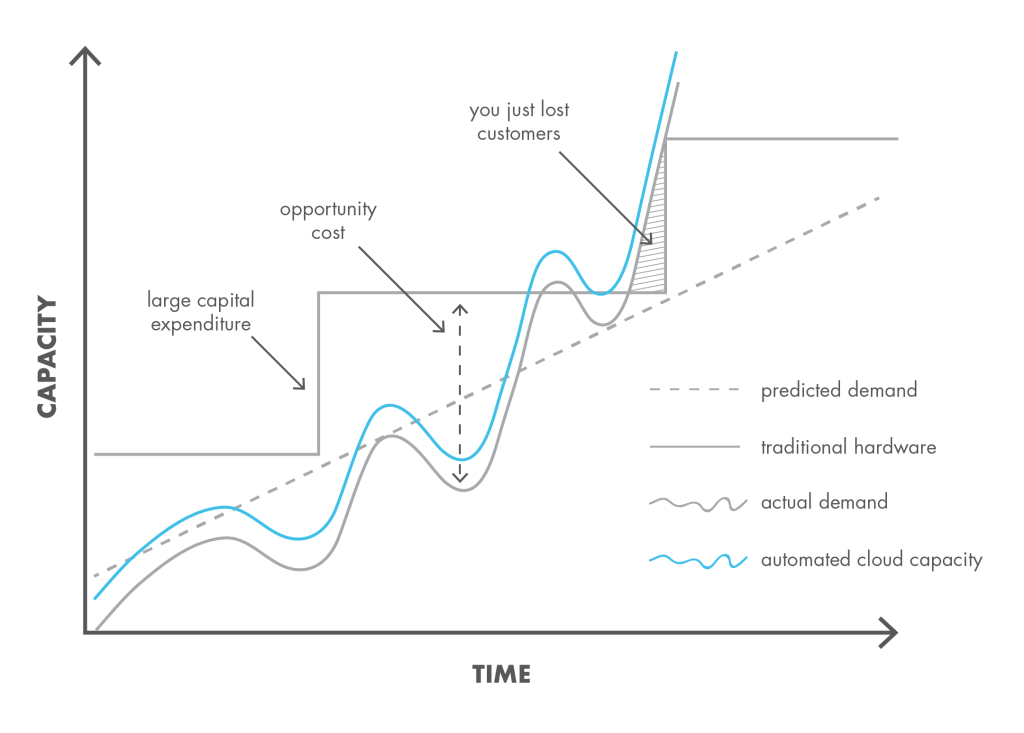The Des Moines metro is committed to creating an environment that…
Why does cloud computing matter? Why should companies move to a cloud platform like AWS, Azure, or the Oracle cloud? Cloud computing is all the rage right now. There are many articles and posts on the Internet (like this one) that discuss the benefits of moving company operations to the cloud. Many of those perks serve the IT department within organizations. This post will show a different perspective; one that views the benefits of cloud computing through a business lens instead of a technical lens.
Every company is different. Even organizations that are direct competitors will have distinct needs. Not all benefits listed in this post will be advantageous for every institution, but should apply to most.
Reasons for business decisions generally boil down to saving either time or money. That being said, even time is really about money. In this post, I’ve grouped benefits by category based on the principal aspect saved, even though the profit could come differently.
Cost Benefits

The cost benefits of cloud computing come first. Business units are frequently required to foot the bill for new technology if it is required as part of a business expansion. Here are some reasons why cloud computing services save businesses money.
Cost vs Capacity

When hardware is purchased for an on-premise installation, the entire cost is required up front. Many businesses are cyclical in their usage, and they have seasons when more computing power is required and seasons when less power is required. Purchasing hardware to meet peak seasons means there are times when it is being underutilized. Essentially, money is being wasted during those low-usage times.
At the other end of the spectrum, if a business venture wildly exceeds expectations, like the recent Popeyes chicken sandwich launch, the hardware purchased may not be able to handle the demand. This leads to lost customers and lost revenue, or at worst, system failure which halts the venture.
Running business operations in the cloud comes with the ability to easily scale the amount of processing power needed to keep systems performing at optimum levels. AWS advertises a feature called AWS Auto Scaling. Azure calls it Azure Autoscale. Even if a particular cloud platform does not automatically scale for you, manual controls exist to allow a business to increase or decrease the capacity of systems. The ability to scale as needed reduces overspend and retains customers.
Pay for What’s Needed
Another direct cost savings relates to the concept of only using resources when you need them. Cloud service providers typically charge fees on a periodic basis as computing services are consumed. Cloud environment configuration controls provide the means to shut down computers. Depending on the business need, entire systems can be turned off or put to sleep. For example, in cases when 24×7 uptime is not required, a business could elect to automatically shut down computers after hours and on the weekends, thereby saving money.
Staff Reduction
It is possible to reduce IT support staff after migrating to the cloud. The same amount of staff that was required to maintain a business’ on-premise hardware may not be needed after a cloud migration. Typically, there are a lot of IT tasks that are reduced or eliminated by using cloud networking and computing services. These include hardware installation, data center rebuilds, configuration, processing backups, dealing with power issues, and handling equipment (air conditioning) failures. At a minimum, IT staff can be refocused to concentrate on growing the business instead of supporting it.
Time Benefits

We’ve all heard the saying “time is money.” It’s never truer than in business. These benefits increase efficiency and save organizations time.
Time to Implement
All projects require time to implement. Traditional project implementations that involve on-premise IT appliances require time to purchase, acquire, and turn on the hardware. In some cases, this work must be finished before any other tasks can be started. However, with cloud computing, new systems can be stood up much faster once the decision has been made to do so. Cloud administrators can spin up new cloud services within hours instead of days. Businesses can begin to build out a new feature much more quickly, thereby decreasing the time it takes to begin implementation.
Time to Market
Sometimes new business ventures require trial and error to develop, as well as testing to perfect. This research and development (R&D) phase can require IT systems months or even years before a production roll-out is expected. Operating in the cloud favors a mindset of experimentation. Business units know they can spin up a cloud environment quickly and inexpensively to explore new possibilities. This reduces the time necessary to examine new procedures and investigate new areas of study which drives a culture of innovation within an organization, allows a business to more easily focus on R&D efforts, and reduces time to market.
Business Continuity
Due to the worldwide scale of cloud computing, all the big players (Microsoft Azure, Oracle Cloud, Amazon AWS, IBM Cloud, Google Cloud Platform) host hundreds of thousands of company systems. It would be a serious detriment to their business if they could not provide their service with minimal downtime. This is one of the major tenets of cloud computing. Due to economies of scale and the ability to move systems to different hosts within the cloud at-will, cloud services boast upwards of 99.99% availability. Systems running in the cloud should rarely go down, unless a business takes them down. This shared risk of failure ensures minimal down time considering millions of people are depending on them.
This benefit is most apparent when it comes to the concept of hardware refreshes. With on-premise solutions, hardware ages and has to be replaced every few years. This causes additional cost and possible down time. Cloud service providers have to do this too, but they do so in a way that is completely transparent to their clients without any noticeable down time.
Miscellaneous Benefits

Finally, here are a few other reasons to migrate business IT resources to the cloud. Though they may not fit as squarely into cost savings or time savings buckets, they too ultimately impact the bottom line.
Lack of Hardware Lifecycle Maintenance
On-premise hardware must be properly maintained so it does not fail. Running services in the cloud does not require IT staff to spend time preserving computer nodes and network hardware. Hardware failure seriously impacts business. Failures aside, freeing up IT resources to focus on new business initiatives is an advantage all its own.
Shared Security
Similar to the point above, because many organizations utilize the same cloud services, economies of scale can be realized. This is especially important when it comes to system security. In some cases, cloud service providers are required by law to build their hosting facilities and infrastructure to prevent security breaches. When utilizing cloud services, a company’s servers sit behind the many layers of protection that have been built for everyone. To some degree, much of the security planning and implementation has been handled by the cloud provider. This gives the client a more secure environment than they could possibly provide themselves.
Staff Focus
Many organizations have IT departments that are seen (right or wrong) as being slow and sometimes unresponsive. Migrating systems and services to the cloud will result in less maintenance headaches for IT and therefore better service to the business. Overall, IT becomes more agile, more responsive, and is quicker to fulfill needed service requests. IT has more time to focus on business initiatives as opposed to keeping the hardware running, which in turn allows the business to be faster in its pursuits.
Conclusion
Though cloud computing is often seen as highly technical, even the most technical of projects and implementation benefit the overall business. Zirous’ experts in cloud computing and cloud adoption — the cultural shift to the cloud — can help you navigate your applications and processes seamlessly.




This Post Has 0 Comments